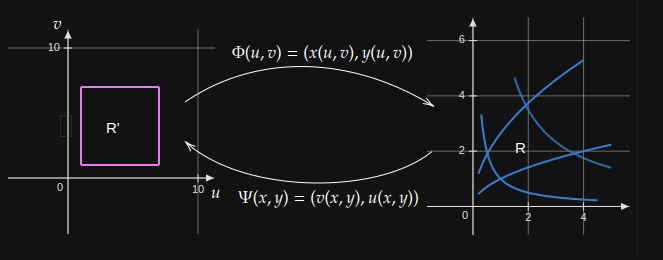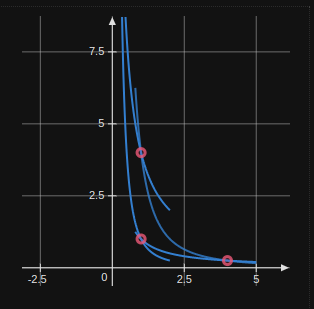
Examples
Example 1. ($R’$ and $\Phi$ are given) Give $B=[0,1]\times[0,1]$ and $\Phi(u,v)=(u^2-v^2,2uv)$. Evaluate $\iint_{\Phi(B)}f(x,y)dxdy$.
💡 Strategy: Use formula directly
sol) $\iint_{\Phi(B)}f(x,y)dxdy=\int_0^1\int_0^1f(u^2-v^2,2uv)(4u^2+4v^2)dudv.$
Example 2. ($\Phi$ and $R$ are given) Given $x=4s+t$ and $y=s-2t$, try to compute the integral $\int_Rx+ydA$, where $R$ is the parallelogram with vertices $(x,y)=(0,0)$, $(4,1)$, $(7,-5)$, and $(3,-6)$.
💡 Strategy: Frist, find the inverse function of $\Phi$, the $\Psi$. Then, use $R$ and $\Psi$ to find $R’$.
sol) To find $\Psi$, we have to solve the system of equations
\[\begin{cases} x=4s+t\\\\ y=s-2t \end{cases}\]for $s$ and $t$. Hence, we have $s=\frac{2x+y}{9}$ and $t=\frac{x-4y}{9}$.
Next, we use the inverse function $\Psi$ to map the points of $R$ to $R’$. The mapped region $R’$ is the rectangle with vertices $(s,t)=\Psi(0,0)=(0,0)$, $\Psi(4,1)=(1,0)$, $\Psi(7,-5)=(1,3)$, and $\Psi(3,-6)=(0,3)$. Therefore, the integral is
\[\iint_Rx+ydA=\int_0^1\int_{0}^{3}(5s-t)\left|\det\left(\begin{matrix}4 & 1\\\\1 &-2\end{matrix}\right)\right|dvdu.\]Example 3. (Only give $R$) Evaluate $\displaystyle\int_{1/4}^{1}\int_{1/x^2}^{4/x}\ln(x^2y)dydx + \int_{1}^4\int_{1/x}^{4/x^2}\ln(x^2y)dydx.$
💡 Strategy: Draw the region $R$, and we will find that $R$ is inclosed by the curve $u(x,y)=c_1$, $u(x,y)=c_2$, $v(x,y)=c_1’$, and $v(x,y)=c_2’$. Then, we will define $\Psi(x,y)=(u(x,y),v(x,y))$ and $R’=[c_1, c_2]\times[c_1’,c_2’]$. Finally, we will find $\Phi$ and use formula to evaluate the integral.Draw the range $R_1=\{(x,y) \frac{1}{4}\leq x\leq 1, \frac{1}{x}\leq y\leq\frac{4}{x^2} \}$ and $R_2=\{(x,y) 1\leq x\leq 4, \frac{1}{x^2}\leq y\leq \frac{4}{x}\}$ toegther. We note that $R_1\cup R_2$ are enclosed by $xy=1$, $xy=4$, $x^2y=1$, and $x^2y=4$. Hence, we define $\Psi(x,y)=(xy, x^2y)$ and $R’ = [1,4]\times[1,4]$. To find $\Phi$, we have to solve the following system of equations

for $x$ and $y$. That is $x=\frac{u^2}{v}$ and $y=\frac{v}{u}$. Therefore, the integral is
\[\int_1^4\int_1^4\ln(v)Jdu dv\]where the jacobian
\[J=\left|\det\left(\begin{matrix}\frac{2u}{v} & -\frac{u^2}{v^2}\\\\-\frac{v}{u^2} & \frac{1}{u}\end{matrix}\right)\right|=\frac{1}{v}.\]Thus, we can use $u$-sub to solve the integral.